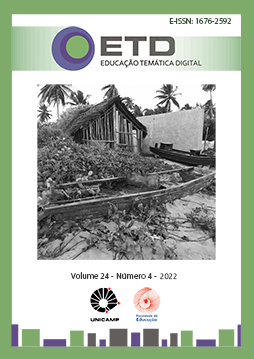Abstract
In 1985 the Ministry of Education in Venezuela initiated the Model of Integral Attention to the Deaf Child, a change from the oralist practice to a bilingual model in the schools for the deaf. This involved eliminating the teaching of spoken Spanish as the main objective, as well as introducing Venezuelan Sign Language (LSV) into the schools. This triggered an intense period of changes which had indelibly marked the local Deaf community. We approach the Model from the perspective of linguistic planning, describing its objectives and its effects on the acquisition, the structure (the corpus) and the status of LSV: LSV and Signed Spanish were relocated in the diglossia existing until then; an academic variant of LSV emerged and the number of LSV users increased. The study was based on the qualitative analysis of interviews with five witnesses of that process.
References
ANZOLA, Myriam. El modelo de educación bilingüe para el niño sordo: La experiencia de Mérida. Fermentum, v.2 n.5, 1992, p. 81-93.
CHARMAZ, Kathy. Constructing grounded theory: a practical guide through qualitative analysis. Londres: Sage Publications, 2006, 224 p.
COOPER, Robert L. Language planning and social change. Cambridge. Cambridge University Press, 1989, 216 p.
DE FINA, Anna. Researcher and informant roles in narrative interactions: Constructions of belonging and foreign-ness. Language in Society v. 40, 2011, p. 27–38.
DE MEULDER, Maartje; MURRAY, Joseph J; y MCKEE, Rachel. The legal recognition of sign languages: advocacy and outcomes around the world. Sidney: Multilingual Matters, 2019, 352 p.
FISHMANN, Joshua. Bilingualism with and without diglossia; diglossia with and without bilingualism. Journal of Social Issues v. 23, n.2, 1967, p. 29–38.
GULATI, Sanjay. Language deprivation syndrom. En: GLICKMANN, Neil; HALL, Wyatte (Ed.). Language deprivation and deaf mental health. Nueva York: Routledge, 2019, p. 24-46.
HOLCOMB, Roy K. Education, History of Total Communication. En: GERZT, Genie; BOUDREALDT, Patrick (Ed.). The SAGE Encyclopedia of Deaf Studies. London: SAGE, 2016, p. 342-343.
LADD, Paddy. Understanding deaf culture. In search of deafhood. Sydney: Multilingual Matters, 2003, 502 p.
MARSCHARK, Mark; SPENCER, Patricia E. (Ed.). The Oxford Handbook of Deaf studies, language, and education. Oxford University Press, 2010, 505 p.
MATHUR, Gaurav; NAPOLI, Donna Jo (Ed.). Deaf around the world: the impact of language. Oxford University Press, 2010, 400 p.
MORALES GARCIA, Ana María. Algunas consideraciones para la implementación de políticas educativas para los sordos en Venezuela. Cultura Sorda, 2006. Disponible en: https://cultura-sorda.org/biblioteca/articulos/educacion/#2006 . Visto el 02/12/2022.
MORALES GARCIA, Ana Maria; PEREZ HERNANDEZ, Yolanda. Bicultural bilingual deaf education in Venezuela: approaching a necessary debate. En: GERNER DE GARCIA, Barbara; KARNOPP, Lodenir Becker (Ed.). Change and promise: bilingual deaf education and deaf culture in Latin America. Washington, DC: Gallaudet University Press, 2016, p. 193-209.
OVIEDO, Alejandro. 1996. Bilingual deaf education in Venezuela: linguistic comments on the current situation. En: LUCAS, Ceil (Ed.) Multicultural aspects of sociolinguistics in deaf communities. Washington D.C.: Gallaudet University Press, 1996, p. 61-77.
OVIEDO, Alejandro; RUMBOS, Henry; PEREZ HERNANDEZ, Yolanda. Los estudios sobre la LSV. En: FREITES, Francisco; PEREZ, Francisco (Ed.) Las disciplinas lingüísticas en Venezuela. Maracaibo: Universidad Cecilio Acosta, 2004, p. 201-33.
PEREZ HERNANDEZ, Yolanda. Los marcadores en LSV. Caracas: UPEL, 2009, 186 p.
PIETROSEMOLI, Lourdes. La LSV: análisis lingüístico. Mérida: ULA, 1991, 182 p.
SANCHEZ, Carlos. La increíble y triste historia de la sordera. Caracas: CEPROSORD, 1990, 126 p.
SANGARISAVAM, Yamuna. Researcher, informant, "assassin", me*. The Geographic Review, v.91, n.1-2, 2010, p. 95-104.
SENGHAS, Ann; KITA, Sotaro; ÖZYÜREK, Asli. Children Creating Core Properties of Language: Evidence from an Emerging Sign Language in Nicaragua. Science, v.305, 2004, p. 1779-82.
SIINER, Maarja; HULT, Francis M.; KUPISH, Tanja (Ed.). Language policy and language acquisition planning. Cham: Springer, 2018, 255 p.
TOLLEFSON, James W.; PEREZ-MILANS, Miguel (Ed.). The Oxford Handbook of language policy and planning. Oxford University Press, 2018, 656 p.
VENEZUELA. Conceptualización y política de la atención educativa integral del deficiente auditivo. Caracas: Ministerio de Educación, 1996, 52 p.
WOLL, Bencie; LADD, Paddy. Deaf Communities. En: MARSCHARK, Mark; SPENCER, Patricia E. (Ed.) The Oxford Handbook of Deaf studies, language, and education. Oxford University Press, 2010, p. 151-63.

This work is licensed under a Creative Commons Attribution-NonCommercial-NoDerivatives 4.0 International License.
Copyright (c) 2022 ETD - Educação Temática Digital


